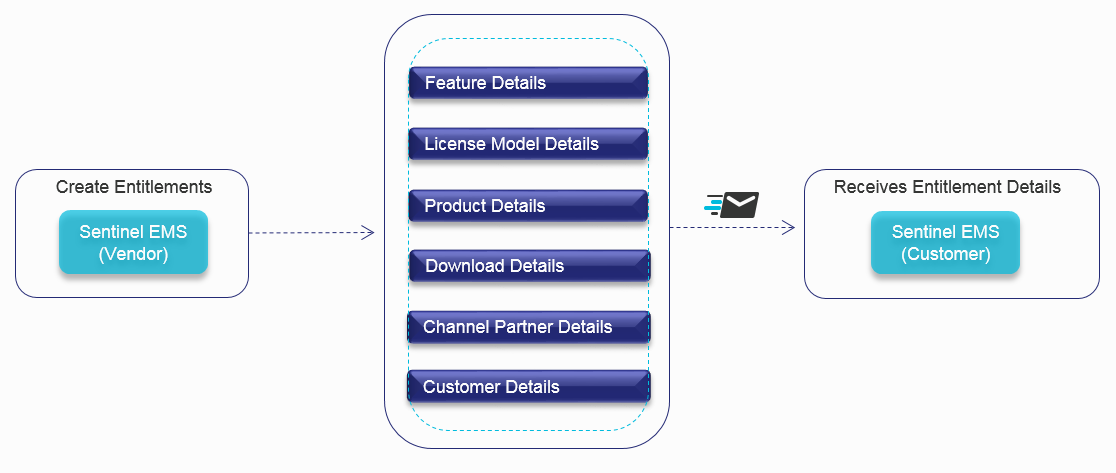Entitlements
|
>Prerequisites for Creating an Entitlement >Entitlement Ownership and Delivery |
>New to Sentinel EMS?
>Starting with Entitlement Creation?
|
What Is an Entitlement?
An entitlement defines the rights of an end user to use a software package or service. An entitlement is an order for products that specifies the product details, who can use these products, and the duration for which the order is valid. The end user can activate the entitlement, which generates a license to use the software according to the defined terms. Each entitlement is identified by a unique entitlement ID (EID). The products associated with an entitlement are identified by unique product keys. An entitlement defines the following:
> Product details. When added to an entitlement, these are referred to as the line items of that entitlement.
> Quantity of the products that can be consumed by the customer.
> Duration for which an entitlement is valid.
>Whether the entitlement must be used as a single entity.
>Whether the entitlement can be activated.
Prerequisites for Creating an Entitlement
>A role that includes Entitlement Management permissions, for example, the Order Taker role. For details, see Roles.
>Access to the required products. Each product must contain at least one associated feature
>For entitlements containing products whose licenses will be activated for the first time, each product must include at least one associated feature or memory file.
>For entitlements containing products that are used for license updates, only product attributes are required. Products can also include associated features and memory files as needed.
Entitlement Ownership and Delivery
The following types of vendor users manage and use entitlements:
>Vendor User: The software vendor employee who is responsible for performing various entitlement-related tasks in Sentinel EMS. These users are assigned access rights in Sentinel EMS using roles. Various teams in the software vendor’s organization are responsible for different entitlement management activities, such as product management, sales, order generation, fulfillment, and customer support. Generic roles can be created for each team, or specific roles can be assigned to each user.
>Channel Partner: An organization that is allowed to re-sell the software vendor’s products. End users can buy directly from the software vendor or from a channel partner.
>Channel Partner User: A channel partner employee that uses Sentinel EMS to manage entitlements for their customers.
>Customer: A current or potential buyer or entitlement user. Typically, a customer is a company or organization. You generate entitlements for a customer who has placed an order.
>User: An end user who may or may not be associated with a customer organization. Often, users are the individuals that activate entitlements.
Customers and users are the end users of an entitlement. Sentinel EMS provides the following portals to generate, deliver, and consume entitlements:
>Vendor Portal: Used by the software vendor's personnel (vendor users) primarily for managing products and entitlements.
>Customer Portal: Used by the software vendor's customers and users. These end users can log on to the portal to activate entitlements. They can also view and edit their profile information.
The following image displays the flow of creating and delivering an entitlement:

Exploring Entitlement Capabilities
Using license management capabilities enables you to generate a versatile set of entitlements including.
>Entitlements for Versionless Products: Sentinel EMS enables vendors to simplify the selling process by creating versionless products and entitlements. With a single versionless entitlement, end users can activate any available product version (variant) within the overall entitlement quantity limit. This avoids SKU explosion in upstream ERP systems and also offers a future-proof mechanism for licensing your products without sacrificing backward compatibility. For details, see Entitlements for Versionless Products.
(For a basic entitlement, customers can activate only the product variants that are defined in that entitlement. Therefore, you must define each version of a product as a separate line item in an entitlement, so that your customers can activate their preferred version. This also constrains you to be aware of the versions required by your customers in advance so that you can create the appropriate entitlements.)
>Batch Entitlements: With Sentinel EMS, you can create entitlements as a batch. The process involves creating a single entitlement in draft state and then configuring it to be generated as a batch by specifying the quantity to be generated. This feature enables you to create large batches of entitlements eliminating the need for small, and low-volume production cycles. For more information, see Configuring a Batch Entitlement.
>Test Entitlements: You can create test entitlements for testing the entitlement workflow and usage. Before generating actual entitlements, you can perform a trial run and generate test entitlements for dummy customers with draft products. Data related to test entitlements does not appear in the reports. However, test entitlements can be activated to generate licenses. For more information, see Test Entitlement Mode.
